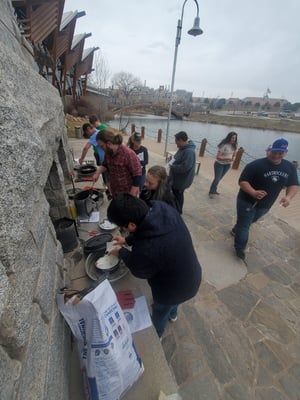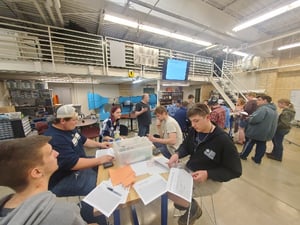Like many Mines alumni, Jada Bell loved math in high school; she excelled in the subject, tackling both calculus III and linear algebra in her freshman year at Mines.

Math skills of Bell’s caliber are somewhat rare, and there is little doubt that she has everything it takes to succeed as a computer science major. But throughout Mines history, even students with the most exceptional skills have sometimes fallen through the cracks. A new program at Mines, funded by the National Science Foundation, aims to improve retention of first-generation college students and to increase the number of talented young people who become STEM professionals. The program has potential to meet a real need. At Mines, one-third of incoming freshmen are first-generation students. On top of this, 36% of Mines students with families below South Dakota’s median income level of $52,000 are first-generation.
“The SD-FIRST program is impacting first-generation students by providing a three-pronged approach to building success through academic, social, and financial support,” says Cassandra Birrenkott, Ph.D., associate professor of mechanical engineering at Mines who leads the SD-FIRST program. The effort connects students to campus resources, creates a social network, and provides needs-based scholarships to alleviate financial burden.
“Current SD-FIRST students have a significant unmet financial need,” says Birrenkott. The average financial need of the first cohort of scholars in the program totaled $14,904 per student. “Financially, first-generation students tend to come from lower income families and have greater responsibility to pay for college on their own.”
This limited financial support from their family means they may be required to hold a job outside of classes. “Students who are working and not focusing on academics as much as they should tend to struggle at Mines,” says Birrenkott. “Our students who are working are also the students who are struggling academically and financially,” adds Alycia Jensen, the SD-FIRST program coordinator.
 Starting in the fall of 2021, 25 students were awarded a total of $117,500 in SD-FIRST scholarships. The program is showing success in the first year. “We had one student struggling while working 30 plus hours a week the first semester. We were in danger of losing him,” says Jensen. “We were able to get him down to 10 hours a week, his grades went up significantly, and he is thriving now.” Birrenkott adds, “There is significant research showing students who are involved in clubs and connected on campus are more successful academically, and for students who are working, it can be difficult to be involved on campus,”
Starting in the fall of 2021, 25 students were awarded a total of $117,500 in SD-FIRST scholarships. The program is showing success in the first year. “We had one student struggling while working 30 plus hours a week the first semester. We were in danger of losing him,” says Jensen. “We were able to get him down to 10 hours a week, his grades went up significantly, and he is thriving now.” Birrenkott adds, “There is significant research showing students who are involved in clubs and connected on campus are more successful academically, and for students who are working, it can be difficult to be involved on campus,”
As the first in their families to attend college and complete a degree, first-generation students can lack experience navigating the higher education world. While other students can call home for advice from parents who have university experience, first-generation students might not have the same support, and for some, higher education hurdles can seem insurmountable.
“Learning to not be intimidated to ask for help when you need it, going to office hours, was something that was very helpful to me but took a little while to get comfortable with,” says Bell.
The program also provides academic and social support to first-generation students by raising awareness of important campus resources, helping them negotiate faculty/staff interactions, sharing opportunities for involvement in clubs and teams, providing a personal connection for overall support, and much more.
“It helped me get connected to other first-generation students and our program coordinators have been awesome,” Bell adds.
The SD-FIRST program gives students like Bell tools to better understand and navigate college culture and encourage higher levels of emotional intelligence, which results in greater involvement in campus life, higher retention and graduation rates, and more first-generation students entering the STEM fields.
For Jesiah Wight, a first-generation civil engineering freshman at Mines, the advice on work-life balance was crucial. Wight holds down a part-time job alongside his studies.
 “They [the SD-FIRST program] give you advice on how to not overwhelm yourself,” says Wight. “One key example is how much time you should spend on your schoolwork compared to your part-time job. They give you actual tools to succeed.”
“They [the SD-FIRST program] give you advice on how to not overwhelm yourself,” says Wight. “One key example is how much time you should spend on your schoolwork compared to your part-time job. They give you actual tools to succeed.”
Wight plans to use his degree in civil engineering to help those in need after graduation. “Ultimately, my goal is to use my degree to do missionary work to help establish infrastructure, buildings or water resources in disaster areas or countries that have never had it.” He says the hands-on lab work he is engaging in at Mines is already inspiring him to continue forward.
“These first-generation students are top-notch, and they have all the abilities in math, science, and other traits needed to excel as engineers. We just need to make sure they know all the tools available to help them succeed,” says Jensen.
The United States and the rest of the world need more scientists and engineers to meet the needs of industry and to overcome the challenges we collectively face. Programs like SD-FIRST will help support students to graduation, benefiting the STEM workforce through an increase in talent pool and diversity.
“Nationally, a larger workforce for STEM fields is needed and the pipeline through the education system must adapt to meet the changing needs. First-generation students are a large, untapped population that can help meet this workforce gap,” says Birrenkott.
The initial success of the effort is promising. Student GPA scores for SD-FIRST students were higher than those of other first-generation freshmen for the FA21 semester. SD-FIRST also has an 88% retention rate in its first semester compared to the average 5-year graduation rate for first-generation students at just 24%.
“These students are our future,” says Birrenkott. The SD-FIRST grant lasts through 2026. Birrenkott says that, thanks to generous donors who have contributed to scholarships and to funds needed to run the program, it will support more students than initially envisioned. In the end, the overall goal is to funnel more students into STEM in order to meet the critical need in our nation for skilled leaders in these fields.



